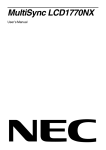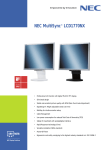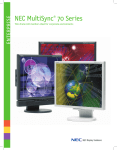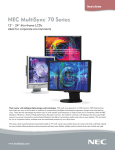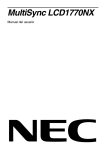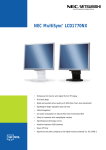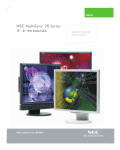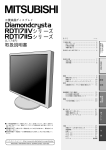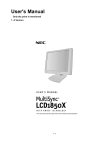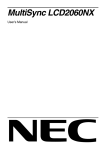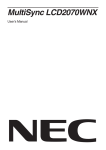Download NEC MultiSync LCD1770NX User's Manual
Transcript
User's Manual MultiSync LCD1770V MultiSync LCD1770NX MultiSync LCD1770NXM Index Warning .................................................................................................................... 1 Contents ................................................................................................................. 2 Sound bar Setup ................................................................................................... 3 Display Setup ......................................................................................................... 4 Mounting ................................................................................................................ 8 Flexible Arm Installation .................................................................................... 9 Controls ................................................................................................................ 10 Recommended Use ............................................................................................... 12 Specifications ...................................................................................................... 14 Features ................................................................................................................. 17 Troubleshooting ................................................................................................... 18 References ............................................................................................................. 19 Limited Warranty ................................................................................................ 20 TCO’99 ..................................................................................................................... 21 TCO’03 .................................................................................................................... 23 Manufacturer’s Recycling and Energy Information ................................... 24 Avertissement ..................................................................................................... 26 Contenu ................................................................................................................. 27 Sound bar Setup ................................................................................................. 28 Display Setup ....................................................................................................... 29 Mounting .............................................................................................................. 33 Commandes .......................................................................................................... 35 Usage recommandé ............................................................................................ 37 Fiche technique ................................................................................................... 40 Fonctions .............................................................................................................. 43 Dépannage ............................................................................................................ 44 Références ........................................................................................................... 45 Garantie limitée .................................................................................................. 46 TCO’99 .................................................................................................................... 47 TCO’03 .................................................................................................................... 49 Informations du fabricant relatives au recylage et aux économies d’énergie ...... 50 WARNING TO PREVENT FIRE OR SHOCK HAZARDS, DO NOT EXPOSE THIS UNIT TO RAIN OR MOISTURE. ALSO, DO NOT USE THIS UNIT'S POLARIZED PLUG WITH AN EXTENSION CORD RECEPTACLE OR OTHER OUTLETS UNLESS THE PRONGS CAN BE FULLY INSERTED. REFRAIN FROM OPENING THE CABINET AS THERE ARE HIGH VOLTAGE COMPONENTS INSIDE. REFER SERVICING TO QUALIFIED SERVICE PERSONNEL. CAUTION CAUTION: TO REDUCE THE RISK OF ELECTRIC SHOCK, MAKE SURE POWER CORD IS UNPLUGGED FROM WALL SOCKET. TO FULLY DISENGAGE THE POWER TO THE UNIT, PLEASE DISCONNECT THE POWER CORD FROM THE AC OUTLET.DO NOT REMOVE COVER (OR BACK). NO USER SERVICEABLE PARTS INSIDE. REFER SERVICING TO QUALIFIED SERVICE PERSONNEL. This symbol warns user that uninsulated voltage within the unit may have sufficient magnitude to cause electric shock. Therefore, it is dangerous to make any kind of contact with any part inside this unit. This symbol alerts the user that important literature concerning the operation and maintenance of this unit has been included. Therefore, it should be read carefully in order to avoid any problems. Canadian Department of Communications Compliance Statement DOC: This Class B digital apparatus meets all requirements of the Canadian Interference-Causing Equipment Regulations. C-UL: Bears the C-UL Mark and is in compliance with Canadian Safety Regulations according to CAN/CSA C22.2 No. 60950-1. FCC Information 1. Use the attached specified cables with the MultiSync® LCD1770V™, LCD1770NX™, and LCD1770NXM™ (L174F) color monitor so as not to interfere with radio and television reception. (1) Please use the supplied power cord or equivalent to ensure FCC compliance. (2) Please use the supplied shielded video signal cable. Use of other cables and adapters may cause interference with radio and television reception. 2. This equipment has been tested and found to comply with the limits for a Class B digital device, pursuant to part 15 of the FCC Rules. These limits are designed to provide reasonable protection against harmful interference in a residential installation. This equipment generates, uses, and can radiate radio frequency energy, and, if not installed and used in accordance with the instructions, may cause harmful interference to radio communications. However, there is no guarantee that interference will not occur in a particular installation. If this equipment does cause harmful interference to radio or television reception, which can be determined by turning the equipment off and on, the user is encouraged to try to correct the interference by one or more of the following measures: • Reorient or relocate the receiving antenna. • Increase the separation between the equipment and receiver. • Connect the equipment into an outlet on a circuit different from that to which the receiver is connected. • Consult your dealer or an experienced radio/TV technician for help. If necessary, the user should contact the dealer or an experienced radio/television technician for additional suggestions. The user may find the following booklet, prepared by the Federal Communications Commission, helpful: ”How to Identify and Resolve Radio-TV Interference Problems.“ This booklet is available from the U.S. Government Printing Office, Washington, D.C., 20402, Stock No. 004-000-00345-4. 1 LCD17PISAManual080604.p65 1 8/6/04, 5:14 PM Contents Your new NEC MultiSync® LCD monitor box* should contain the following: • MultiSync LCD1770V, LCD1770NX, or LCD1770NXM monitor with height adjustable stand • Power Cord • User’s Manual • Video Signal Cable • Cable Management Cover • USB Cable (NX/NXM only) • Audio Cable (NXM only) • Sound bar (NXM only) • Thumbscrews x 2 (NXM only) Power Cord Video Signal Cable Cable Management Cover Sound bar (NXM only) Thumbscrews (NXM only) User's Manual MultiSync LCD1770V MultiSync LCD1770NX MultiSync LCD1770NXM User’s Manual USB Cable (NX/NXM only) Audio Cable (NXM only) * Remember to save your original box and packing material to transport or ship the monitor. 2 LCD17PISAManual080604.p65 2 8/6/04, 5:14 PM Sound bar Setup To attach the Sound bar to your LCD1770NXM, follow these instructions. Note: this setup is only for the LCD1770NXM. If you have purchase an LCD1770V or LCD1770NX, please move to the next page. 1. Turn off the computer. 2. Place hands on each side of the display to tilt up the panel and then lift up to the highest position. 3. Use the two thumb screws included to attach the Sound bar to the display (Figure SB.1). 4. Turn the volume control down on the Soundbar (Figure SB.2). 5. Connect the light blue color audio cable plug to the light blue jack of Sound bar (Figure SB.1). Connect the other end of the audio cable into the back of your computer. NOTE: Headphones may be connected to the headphones jack on the right side of the Sound bar (Figure SB.2). Headphones can be purchased from your local electronics store. 6. Connect the DC power cable of Sound bar to DC-OUT terminal of display (Figure SB.1). 7. You are now ready to move to the next step in setting up your MultiSync LCD. Figure SB.1 DC-OUT Terminal of Display Thumb Screw Thumb Screw Audio DC Power Cable Cable Figure SB.2 Headphone Jack VOL. VOL. Volume Control 3 LCD17PISAManual080604.p65 3 8/6/04, 5:14 PM Display Setup To attach the MultiSync® LCD monitor to your system, follow these instructions: 1. Turn off the power to your computer. 2. For the PC or MAC with DVI digital output (NX and NXM only): Connect the DVI signal cable (not included) to the connector of the display card in your system (Figure 1). Tighten all screws. For the PC with Analog output: Connect the 15-pin mini D-SUB signal cable to the connector of the display card in your system (Figure 2). Tighten all screws. For MAC setup: Connect the Macintosh cable adapter to the computer, then attach the 15-pin mini D-SUB signal cable to the Macintosh cable adapter (Figure 3). Tighten all screws. NOTE: To obtain the MultiSync Macintosh cable adapter, call NEC-Mitsubishi Electronics Display of America, Inc. at (800) 632-4662. 3. Place hands on each side of the monitor to tilt the LCD panel 30-degree angle and lift up to the highest position (Figure 4). 4. Connect all cables to the appropriate connectors (Figure 4). NOTE: If connecting both DVI and D-sub cable, the DVI cable must be connected along side the rib on the power cord side (Figure 4). 5. For successful cable management, place the cables in this order into the cable management: audio cable (NXM only), power cable, and DVI cable (Figure 5). 6. Place DVI cable, audio cable (NXM only), and power cable into the specific hooks indicated in Figure 6. 7. Place the D-Sub and the USB cable (NX and NXM only) into the specific hooks indicated in Figure 7. 8. Make sure all cables are resting flat against the stand (Figure 7). 9. Hold the all cables firmly and place the cable cover onto the stand (Figure 8). To remove the cable cover, lift the cover off as shown in Figure 9. 10. Connect the power cord to the power outlet (Figure 10). NOTE: If you use this monitor at AC125-240V, please refer to Recommended Use section of this manual for proper selection of power cord. 11. The vacation switch on the back side of the monitor must be turned on (Figure 10). Turn on the monitor with the front power button and the computer. NOTE: The vacation switch is a true on/off switch. If this switch is on the OFF position, the monitor cannot be turned on using the front button. DO NOT switch on/off repeatedly. 12. Analog input only: No-Touch Auto Adjust automatically adjusts the monitor to optimal settings upon initial setup for most timings. For further adjustments, use the following OSM® controls: • Auto Adjust Contrast • Auto Adjust Refer to the Controls section of this User ’s Manual for a full description of these OSM controls. NOTE: For download information on the Windows® 95/98/Me/2000/XP INF file for your monitor, refer to the References section of this User’s Manual. NOTE: If you have any problems, please refer to the Troubleshooting section of this User’s Manual. 4 LCD17PISAManual080604.p65 4 8/6/04, 5:14 PM Display Setup –continued Figure 1 Figure 2 DVI Signal Cable (not included) (NX and NXM only) Figure 3 Macintosh Cable Adapter (not included) Note: Some Macintosh systems do not require a Macintosh Cable Adapter 30˚ Tilt Figure 4 Figure 5 DVI Cable (Top) Highest Stand Position Power Cable (Middle) Audio Cable (Bottom) (NMX only) DVI Cable Figure 6 DVI Cable Audio Cable Ridge Power Cable (NMX only) 5 LCD17PISAManual080604.p65 5 8/6/04, 5:14 PM Display Setup –continued Figure 7 D-Sub Cable USB Cable (NX and NMX only) Flat Figure 8 Figure 9 Insert Top First Then Bottom Figure 10 Vacation Switch ON Position Power Button 6 LCD17PISAManual080604.p65 6 OFF Position 8/6/04, 5:14 PM Display Setup –continued Raise and Lower Monitor Screen The monitor may be raised or lowered. To raise or lower screen, place hands on each side of the monitor and lift or lower to the desired height (Figure RL.1). NOTE: Handle with care when raising or lowering the monitor screen. Figure RL.1 Tilt and Swivel Grasp both sides of the monitor screen with your hands and adjust the tilt and swivel as desired (Figure TS.1). NOTE: Handle with care when tilting and swiveling the monitor screen. Figure TS.1 7 LCD17PISAManual080604.p65 7 8/6/04, 5:14 PM Mounting Remove Monitor Stand for Mounting To prepare the monitor for alternate mounting purposes: 1. Place hands on each side of the monitor and lift up to the highest position. Remove the cable cover (Figure M.1). 2. Disconnect all cables. 3. Place monitor face down on a non-abrasive surface (Figure M.2). 4. Remove the 2 screws connecting the stand to the monitor (FigureM.2). 5. Lift up the stand to unlatch the upper hooks and remove the stand (FigureM.3). 6. Remove the 2 screws on the top of the monitor (FigureM.4). The monitor is now ready for mounting in an alternate manner. 7. Connect the cables to the back of the monitor. 8. Reverse this process to reattach stand. NOTE: Use only VESA-compatible alternative mounting method. Handle with care when removing stand. Figure M.2 Figure M.1 Figure M.3 Figure M.4 8 LCD17PISAManual080604.p65 8 8/6/04, 5:15 PM Flexible Arm Installation This LCD monitor is designed for use with a flexible arm. To mount the monitor to a flexible arm: 1. Follow the instructions on how Remove Monitor Stand for Mounting to remove the stand. 2. Using the 4 screws from the stand removal and attach the arm to the monitor (Figure F.1). NOTE: The LCD monitor should only be used with an approved arm (e.g. GS mark). To meet the safety requirements, the monitor must be mounted to an arm which guaranties the necessary stability under consideration of the weight of the monitor. Thickness of Bracket (Arm) Figure F.1 2.0~3.2mm 100mm 100mm 4 Screws (4M) (Max Depth: 8.5mm) Weight of LCD assembly: 4.7kg (MAX) 4.2kg (LCD1770V) 4.3kg (LCD1770NX) 4.7kg (LCD1770NXM) 9 LCD17PISAManual080604.p65 9 8/6/04, 5:15 PM Controls OSM® (On-Screen Manager) control buttons on the front of the monitor function as follows: To access OSM menu, press any of the control buttons (MENU/EXIT, Left, Right, Down, Up). To change signal input, press the SELECT button (NX and NXM only). NOTE: OSM must be closed in order to change signal input. Button Menu MENU/EXIT Exits the OSM controls. Exits to the OSM main menu. Left/Right Moves the highlighted area left/right to select control menus. Moves the bar left/right to increase or decrease the adjustment. Down/Up Moves the highlighted area down/up to select one of the controls. SELECT Active Auto Adjust function. Enter the OSM sub menu. RESET Resets the highlighted control menu to the factory setting. NOTE: When RESET is pressed in the main and sub-menu, a warning window will appear allowing you to cancel the RESET function by pressing the MENU/EXIT button. Brightness/Contrast Controls BRIGHTNESS Adjusts the overall image and background screen brightness. CONTRAST Adjusts the image brightness in relation to the background. AUTO Contrast (Analog input only) Adjusts the image displayed to optimal settings. Auto Adjust (Analog input only) Automatically adjusts the Image Position, H. Size and Fine settings. Image Controls (Analog input only) LEFT / RIGHT Controls Horizontal Image Position within the display area of the LCD. DOWN / UP Controls Vertical Image Position within the display area of the LCD. H.SIZE Adjusts the horizontal size by increasing or decreasing this setting. FINE Improves focus, clarity and image stability by increasing or decreasing this setting. AccuColor® Control Systems AccuColor® Control Systems: Six color presets select the desired color setting (sRGB and NATIVE color presets are standard and cannot be changed). R,G,B: Increases or decreases Red, Green or Blue color depending upon which is selected. The change in color will appear on screen and the direction (increase or decrease) will be shown by the bars. 10 LCD17PISAManual080604.p65 10 8/6/04, 5:15 PM Controls –continued NATIVE: Original color presented by the LCD panel that is unadjustable. sRGB: sRGB mode dramatically improves the color fidelity in the desktop environment by a single standard RGB color space. With this color supported environment, the operator could easily and confidently communicate color without further color management overhead in the most common situations. Tools OFF TIMER: Monitor will automatically power-down when the end user has selected a predetermined amount of time. HOT KEY: You can adjust the brightness and contrast directly. When this function is set to ON, you can adjust the brightness with left or right control and contrast with up or down control while the OSM menu is off. FACTORY PRESET: Selecting Factory Preset allows you to reset all OSM control settings back to the factory settings. The RESET button will need to be held down for several seconds to take effect. Individual settings can be reset by highlighting the control to be reset and pressing the RESET button. Menu Tools LANGUAGE: OSM® control menus are available in eight languages. OSM LEFT/RIGHT: You can choose where you would like the OSM control image to appear horizontally on your screen. OSM DOWN/UP: You can choose where you would like the OSM control image to appear vertically on your screen. OSM TURN OFF: The OSM control menu will stay on as long as it is in use. In the OSM Turn Off submenu, you can select how long the monitor waits after the last touch of a button to shut off the OSM control menu. OSM LOCK OUT: This control completely locks out access to all OSM control functions without Brightness and Contrast. When attempting to activate OSM controls while in the Lock Out mode, a screen will appear indicating the OSM controls are locked out. To activate the OSM Lock Out function, press SELECT, then right control button and hold down simultaneously. To deactivate the OSM Lock Out, press SELECT, then left control button and hold down simultaneously while in the OSM menu. RESOLUTION NOTIFIER: This optimal resolution is 1280 x 1024. If ON is selected, a message will appear on the screen after 30 seconds, notifying you that the resolution is not at 1280 x 1024. Information The Information menu indicates the current input, display resolution, horizontal and vertical frequency, and polarity settings of the monitor. The model and serial numbers of your monitor are also indicated. 11 LCD17PISAManual080604.p65 11 8/6/04, 5:15 PM Recommended Use Safety Precautions and Maintenance FOR OPTIMUM PERFORMANCE, PLEASE NOTE THE FOLLOWING WHEN SETTING UP AND USING THE MULTISYNC® LCD COLOR MONITOR: • DO NOT OPEN THE MONITOR. There are no user serviceable parts inside and opening or removing covers may expose you to dangerous shock hazards or other risks. Refer all servicing to qualified service personnel. • Do not spill any liquids into the cabinet or use your monitor near water. • Do not insert objects of any kind into the cabinet slots, as they may touch dangerous voltage points, which can be harmful or fatal or may cause electric shock, fire or equipment failure. • Do not place any heavy objects on the power cord. Damage to the cord may cause shock or fire. • Do not place this product on a sloping or unstable cart, stand or table, as the monitor may fall, causing serious damage to the monitor. • When operating the MultiSync LCD monitor with its AC 125-240V power supply, use a power supply cord that matches the power supply voltage of the AC power outlet being used. The power supply cord you use must have been approved by and comply with the safety standards of your country. (Type H05VV-F should be used in Europe) • In UK, use a BS-approved power cord with molded plug having a black (5A) fuse installed for use with this monitor. If a power cord is not supplied with this monitor, please contact your supplier. • Do not place any objects onto the monitor and do not use the monitor outdoors. • The inside of the flourescent tube located within the LCD monitor contains mercury. Please follow the bylaws or rules of your municipality to dispose of the tube properly. • Do not bend power cord. • Do not use monitor in high temperatured, humid, dusty, or oily areas. • Do not cover vent on monitor. Immediately unplug your monitor from the wall outlet and refer servicing to qualified service personnel under the following conditions: • When the power supply cord or plug is damaged. • If liquid has been spilled, or objects have fallen into the monitor. • If the monitor has been exposed to rain or water. • If the monitor has been dropped or the cabinet damaged. • If the monitor does not operate normally by following operating instructions. • If glass is broken, handle with care. • If monitor or glass is broken, do not come in contact with the liquid crystal and handle with care. • Allow adequate ventilation around the monitor so that heat can properly dissipate. Do not block ventilated openings or place the monitor near a radiator or other heat sources. Do not put anything on top of monitor. • The power cable connector is the primary means of detaching the system from the power supply. The monitor should be installed close to a power outlet which is easily accessible. • Handle with care when transporting. Save packaging for transporting. CAUTION Image Persistence Please be aware that LCD Technology may experience a phenomena known as Image Persistence. Image Persistence occurs when a residual or “ghost” image of a previous image remains visible on the screen. Unlike CRT monitors, LCD monitors’ image persistence is not permanent, but constant images being displayed for a long period of time should be avoided. To alleviate image persistence, turn off the monitor for as long as the previous image was displayed. For example, if an image was on the monitor for one hour and a residual image remains, the monitor should be turned off for one hour to erase the image. As with all personal display devices, NEC-Mitsubishi Electronics Display recommends displaying moving images and using a moving screen saver at regular intervals whenever the screen is idle or turning off the monitor when not in use. 12 LCD17PISAManual080604.p65 12 8/6/04, 5:15 PM Recommended Use –continued CORRECT PLACEMENT AND ADJUSTMENT OF THE MONITOR CAN REDUCE EYE, SHOULDER AND NECK FATIGUE. CHECK THE FOLLOWING WHEN YOU POSITION THE MONITOR: • For optimum performance, allow 20 minutes for warm-up. • Adjust the monitor height so that the top of the screen is at or slightly below eye level. Your eyes should look slightly downward when viewing the middle of the screen. • Position your monitor no closer than 16 inches and no further away than 28 inches from your eyes. The optimal distance is 20 inches. • Rest your eyes periodically by focusing on an object at least 20 feet away. Blink often. • Position the monitor at a 90° angle to windows and other light sources to minimize glare and reflections. Adjust the monitor tilt so that ceiling lights do not reflect on your screen. • If reflected light makes it hard for you to see your screen, use an anti-glare filter. • Adjust the monitor’s brightness and contrast controls to enhance readability. • Use a document holder placed close to the screen. • Position whatever you are looking at most of the time (the screen or reference material) directly in front of you to minimize turning your head while you are typing. • Get regular eye checkups. Ergonomics To realize the maximum ergonomics benefits, we recommend the following: • Use the preset Size and Position controls with standard signals • Use the preset Color Setting • Use non-interlaced signals with a vertical refresh rate between 60-75Hz • Do not use primary color blue on a dark background, as it is difficult to see and may produce eye fatigue to insufficient contrast. For more detailed information on setting up a healthy work environment, write the American National Standard for Human Factors Engineering of Visual Display Terminal Workstations – ANSI-HFS Standard No. 100-1988 – The Human Factors Society, Inc. P.O. Box 1369, Santa Monica, California 90406. Cleaning the LCD Panel • When the liquid crystal panel is stained with dust or dirt, please wipe with soft cloth gently. • Please do not rub the LCD panel with hard material. • Please do not apply pressure to the LCD surface. • Please do not use OA cleaner it will cause deterioration or discolor on the LCD surface. Cleaning the Cabinet • Unplug the power supply • Gently wipe the cabinet with a soft cloth • To clean the cabinet, dampen the cloth with a neutral detergent and water, wipe the cabinet and follow with a dry cloth. NOTE: Many plastics are used on the surface of the cabinet. DO NOT clean with benzene, thinner, alkaline detergent, alcoholic system detergent, glass cleaner, wax, polish cleaner, soap powder, or insecticide. Do not touch rubber or vinyl to the cabinet for a long time. These types of fluids and fabrics can cause the paint to deteriorate, crack or peel. 13 LCD17PISAManual080604.p65 13 8/6/04, 5:15 PM Specifications Monitor Specifications MultiSync® LCD1770V™ Monitor LCD Module Diagonal : Viewable Image Size : Native Resolution (Pixel Count) : 17.0 inch 17.0 inch 1280 x 1024 Input Signal Video : Sync : Active matrix; thin film transistor (TFT) liquid crystal display (LCD); 0.264 mm dot pitch; 250cd/m2 white luminence; 450:1 contrast ratio, typical ANALOG 0.7 Vp-p/75 Ohms Separate sync. TTL Level Horizontal sync. Positive/Negative Vertical sync. Positive/Negative Display Colors Maximum 16,194,277 Left/Right : Dependent on display card used. 80°/80° (CR>5) Viewing Angles Up/Down : 75°/70° (CR>5) Synchronization Range Horizontal : Vertical : 31.5 kHz to 81.0 kHz 56.0 Hz to 75.0 Hz Resolutions Supported Active Display Area Notes Automatically Automatically 720 x 400*1 :VGA text Some systems may not support all modes listed. 640 x 480*1 @ 60 Hz to 75 Hz 800 x 600*1 @ 56 Hz to 75 Hz 832 x 624*1 @ 75 Hz 1024 x 768*1 @ 60 Hz to 75 Hz 1152 x 870*1 @ 75 Hz 1280 x 1024 @ 60 Hz to 75 Hz .......................... NEC-Mitsubishi Electronics Display cites recommended resolution at 60 Hz for optimal display performance. Horizontal : Vertical : 337.9 mm/13.3 inches 270.3 mm/10.6 inches Power Supply 100 – 240 V ~ 50/60 Hz Current Rating 0.7 – 0.36A Dimensions 367.0 mm (W) x 362.5-472.5 mm (H) x 198.0 mm (D) 14.4 inches (W) x 14.3-18.6 inches (H) x 7.8 inches (D) Weight 6.0 kg 13.2 lbs Environmental Considerations Operating Temperature : Humidity : Feet : Storage Temperature : Humidity : Feet : 5°C to 35°C/41°F to 95°F 30% to 80% 0 to 10,000 Feet -10°C to 60°C/14°F to 140°F 10% to 85% 0 to 30,000 Feet *1 Interpolated Resolutions: When resolutions are shown that are lower than the pixel count of the LCD module, text may appear different. This is normal and necessary for all current flat panel technologies when displaying non-native resolutions full screen. In flat panel technologies, each dot on the screen is actually one pixel, so to expand resolutions to full screen, an interpolation of the resolution must be done. NOTE: Technical specifications are subject to change without notice. 14 LCD17PISAManual080604.p65 14 8/6/04, 5:15 PM Specifications –continued Monitor Specifications MultiSync® LCD1770NX Monitor LCD Module Diagonal : Viewable Image Size : Native Resolution (Pixel Count) : 17.0 inch 17.0 inch 1280 x 1024 Active matrix; thin film transistor (TFT) liquid crystal display (LCD); 0.264 mm dot pitch; 250cd/m2 white luminence; 500:1 contrast ratio, typical Input Signal Video : Sync : ANALOG 0.7 Vp-p/75 Ohms Separate sync. TTL Level Horizontal sync. Positive/Negative Vertical sync. Positive/Negative Digital Input: DVI 16,194,277 Dependent on display card used. Display Colors Maximum Left/Right : 80°/80° (CR>5) Viewing Angles Up/Down : 85°/75° (CR>5) Synchronization Range Horizontal : 31.5 kHz to 81.0 kHz (Analog) 31.5 kHz to 69.0 kHz (Digital) 56.0 Hz to 75.0 Hz Vertical : Resolutions Supported Active Display Area USB Hub Notes Automatically Automatically Automatically 720 x 400*1 :VGA text Some systems may not support all modes listed. 640 x 480*1 @ 60 Hz to 75 Hz 800 x 600*1 @ 56 Hz to 75 Hz 832 x 624*1 @ 75 Hz 1024 x 768*1 @ 60 Hz to 75 Hz 1152 x 870*1 @ 75 Hz 1280 x 1024 @ 60 Hz to 75 Hz (Analog) ......... NEC-Mitsubishi Electronics Display cites 1280 x 1024 @ 60 Hz (Digital) recommended resolution at 60 Hz for optimal display performance. Horizontal : Vertical : 337.9 mm/13.3 inches 270.3 mm/10.6 inches I/P: Port: USB Specification Revision 2.0 Upstream 1 Downstream 4 Maximum 0.5A per port Load Current: Power Supply 100 – 240 V ~ 50/60 Hz Current Rating 0.7 – 0.36A Dimensions 367.0 mm (W) x 362.5-472.5 mm (H) x 198.0 mm (D) 14.4 inches (W) x 14.3-18.6 inches (H) x 7.8 inches (D) Weight 6.1 kg 13.4 lbs Environmental Considerations Operating Temperature : Humidity : Feet : Storage Temperature : Humidity : Feet : 5°C to 35°C/41°F to 95°F 30% to 80% 0 to 10,000 Feet -10°C to 60°C/14°F to 140°F 10% to 85% 0 to 30,000 Feet *1 Interpolated Resolutions: When resolutions are shown that are lower than the pixel count of the LCD module, text may appear different. This is normal and necessary for all current flat panel technologies when displaying non-native resolutions full screen. In flat panel technologies, each dot on the screen is actually one pixel, so to expand resolutions to full screen, an interpolation of the resolution must be done. NOTE: Technical specifications are subject to change without notice. 15 LCD17PISAManual080604.p65 15 8/6/04, 5:15 PM Specifications –continued Monitor Specifications MultiSync® LCD1770NXM Monitor LCD Module Diagonal : Viewable Image Size : Native Resolution (Pixel Count) : 17.0 inch 17.0 inch 1280 x 1024 Active matrix; thin film transistor (TFT) liquid crystal display (LCD); 0.264 mm dot pitch; 250cd/m2 white luminence; 500:1 contrast ratio, typical Input Signal Video : Sync : ANALOG 0.7 Vp-p/75 Ohms Separate sync. TTL Level Horizontal sync. Positive/Negative Vertical sync. Positive/Negative Digital Input: DVI 16,194,277 Dependent on display card used. Display Colors Maximum Left/Right : 80°/80° (CR>5) Viewing Angles Up/Down : 85°/75° (CR>5) Synchronization Range Horizontal : 31.5 kHz to 81.0 kHz (Analog) 31.5 kHz to 69.0 kHz (Digital) 56.0 Hz to 75.0 Hz Vertical : Resolutions Supported Active Display Area Notes Automatically Automatically Automatically 720 x 400*1 :VGA text Some systems may not support all modes listed. 640 x 480*1 @ 60 Hz to 75 Hz 800 x 600*1 @ 56 Hz to 75 Hz 832 x 624*1 @ 75 Hz 1024 x 768*1 @ 60 Hz to 75 Hz 1152 x 870*1 @ 75 Hz 1280 x 1024 @ 60 Hz to 75 Hz (Analog) ......... NEC-Mitsubishi Electronics Display cites 1280 x 1024 @ 60 Hz (Digital) recommended resolution at 60 Hz for optimal display performance. Horizontal : Vertical : USB Hub I/P: Port: Speakers Practical Audio Output: 337.9 mm/13.3 inches 270.3 mm/10.6 inches USB Specification Revision 2.0 Upstream 1 Downstream 4 Maximum 0.5A per port Load Current: 2.0 W + 2.0 W Power Supply 100 – 240 V ~ 50/60 Hz Current Rating 0.7 – 0.36A Dimensions 367.0 mm (W) x 368.6-472.5 mm (H) x 198.0 mm (D) 14.4 inches (W) x 14.5-18.6 inches (H) x 7.8 inches (D) Weight 6.5 kg 14.3 lbs Environmental Considerations Operating Temperature : Humidity : Feet : Storage Temperature : Humidity : Feet : 5°C to 35°C/41°F to 95°F 30% to 80% 0 to 10,000 Feet -10°C to 60°C/14°F to 140°F 10% to 85% 0 to 30,000 Fee























































